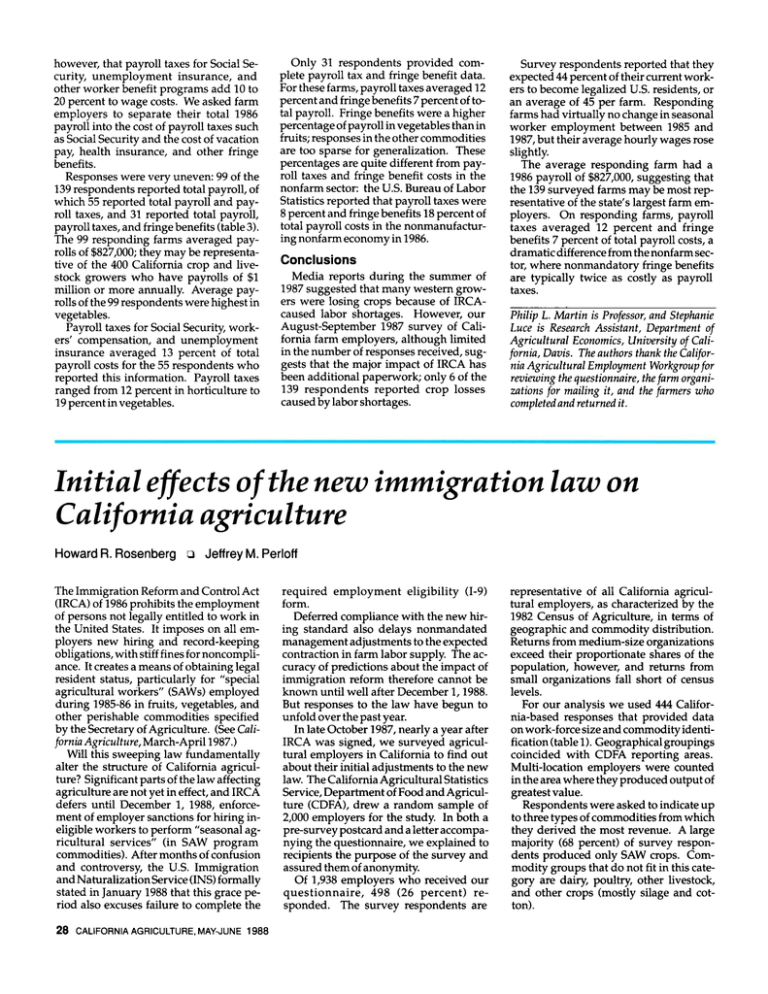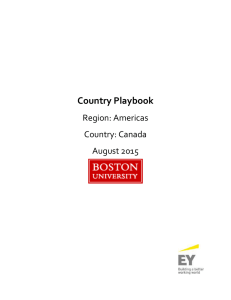Document 10316169
advertisement

however, that payroll taxes for Social Security, unemployment insurance, and other worker benefit programs add 10 to 20 percent to wage costs. We asked farm employers to separate their total 1986 payroll into the cost of payroll taxes such as Social Security and the cost of vacation pay, health insurance, and other fringe benefits. Responses were very uneven: 99 of the 139 respondents reported total payroll, of which 55 reported total payroll and payroll taxes, and 31 reported total payroll, payroll taxes, and fringe benefits (table3). The 99 responding farms averaged payrolls of $827,000; they may be representative of the 400 California crop and livestock growers who have payrolls of $1 million or more annually. Average payrolls of the 99 respondents were highest in vegetables. Payroll taxes for Social Security, workers’ compensation, and unemployment insurance averaged 13 percent of total payroll costs for the 55 respondents who reported this information. Payroll taxes ranged from 12 percent in horticulture to 19percent in vegetables. Only 31 respondents provided complete payroll tax and fringe benefit data. For these farms, payroll taxes averaged 12 percent and fringe benefits 7 percent of total payroll. Fringe benefits were a higher percentageof payroll in vegetablesthan in fruits; responses in the other commodities are too sparse for generalization. These percentages are quite different from payroll taxes and fringe benefit costs in the nonfarm sector: the U.S. Bureau of Labor Statistics reported that payroll taxes were 8 percent and fringe benefits 18 percent of total payroll costs in the nonmanufacturing nonfarm economy in 1986. Conclusions Media reports during the summer of 1987 suggested that many western growers were losing crops because of IRCAcaused labor shortages. However, our August-September 1987 survey of California farm employers, although limited in the number of responses received, suggests that the major impact of IRCA has been additional paperwork; only 6 of the 139 respondents reported crop losses caused by labor shortages. Survey respondents reported that they expected 44 percent of their current workers to become legalized U.S. residents, or an average of 45 per farm. Responding farms had virtually no change in seasonal worker employment between 1985 and 1987,but their average hourly wages rose slightly. The average responding farm had a 1986 payroll of $827,000, suggesting that the 139 surveyed farms may be most representative of the state’s largest farm employers. On responding farms, payroll taxes averaged 12 percent and fringe benefits 7 percent of total payroll costs, a dramatic differencefrom the nonfarm sector, where nonmandatory fringe benefits are typically twice as costly as payroll taxes. Philip L. Martin is Professor, and Stephanie Luce is Research Assistant, Department of Agricultural Economics, University of California, Davis. The authors thank the California Agricultural Employment Workgroupfor reviewing the questionnaire, the farm organizations for mailing it, and the farmers who completed and returned it. Initial efiects of the new immigration law on Calif o m i a agricu 1ture Howard R. Rosenberg a Jeffrey M.Perloff The Immigration Reform and Control Act (IRCA)of 1986 prohibits the employment of persons not legally entitled to work in the United States. It imposes on all employers new hiring and record-keeping obligations,with stiff fines for noncompliance. It creates a means of obtaining legal resident status, particularly for “special agricultural workers” (SAWS)employed during 1985-86 in fruits, vegetables, and other perishable commodities specified by the Secretary of Agriculture. (See California Agriculture, March-April 1987.) Will this sweeping law fundamentally alter the structure of California agriculture? Significantparts of the law affecting agriculture are not yet in effect, and IRCA defers until December 1, 1988, enforcement of employer sanctions for hiring ineligible workers to perform ”seasonal agricultural services” (in SAW program commodities).After months of confusion and controversy, the U.S. Immigration and Naturalizationservice (INS)formally stated in January 1988 that this grace period also excuses failure to complete the 28 CALIFORNIA AGRICULTURE. MAY-JUNE 1988 required employment eligibility (1-9) form. Deferred compliance with the new hiring standard also delays nonmandated management adjustments to the expected contraction in farm labor supply. The accuracy of predictions about the impact of immigration reform therefore cannot be known until well after December 1,1988. But responses to the law have begun to unfold over the past year. In late October 1987, nearly a year after IRCA was signed, we surveyed agricultural employers in California to find out about their initial adjustments to the new law. The California Agricultural Statistics Service,Department of Food and Agriculture (CDFA), drew a random sample of 2,000 employers for the study. In both a pre-survey postcard and a letter accompanying the questionnaire, we explained to recipients the purpose of the survey and assured them of anonymity. Of 1,938 employers who received our questionnaire, 498 (26 percent) responded. The survey respondents are representative of all California agricultural employers, as characterized by the 1982 Census of Agriculture, in terms of geographic and commodity distribution. Returns from medium-size organizations exceed their proportionate shares of the population, however, and returns from small organizations fall short of census levels. For our analysis we used 444 California-based responses that provided data on work-force size and commodityidentification (table 1). Geographicalgroupings coincided with CDFA reporting areas. Multi-location employers were counted in the area where they produced output of greatest value. Respondents were asked to indicate up to three types of commoditiesfrom which they derived the most revenue. A large majority (68 percent) of survey respondents produced only SAW crops. Commodity groups that do not fit in this category are dairy, poultry, other livestock, and other crops (mostly silage and cotton). Average farm size reported was 17.8 employees year-round, 64.3 at seasonal peak. Peak employment ranged up to 1,900, although half the farms employed 20 or fewer workers. About 65 percent of respondents operated in more than one location. Slightly more than a third regularly attended meetings of a trade or commodity association. During the two years preceding the survey, the INS Border Patrol had visited 22.2 percent of respondent farms to question employees about their right to be in the United States. Less than 2 percent had any employees represented by a union. Those farms were much larger than average, and 9 percent of seasonal peak employees in the sample overallwere unionized. Survey findings Our preliminary findingsare organized in six sections: 1. Do California agriculturalemployers understand the new immigrationlaw? 2. How heavily does California agriculture rely on alien labor? 3. Is IRCA causing farmers to employ fewer aliens? 4. Has the law already caused labor shortages and crop loss? 5. Are agricultural employers helping their current and former alien employees to become legal residents? 6. Are employers changing their management practices to attract and retain more legally employableworkers? tual knowledge of major IRCA provisions. On average, only 6.2 (51.8 percent) of the 12 items were answered correctly; 21.2 percent of answers on the true-false items were "unsure." Only 7.8 percent felt very certain about what IRCA requires of them. Employers in this group did better on the 12-item "exam" than groups who were less certain, but they still missed more than onethird of the questions (fig. 1). Only a third of them filled in the correct maximum fine for hiring an ineligiblealien. 2. Aliens in agriculture Our survey confirmed the widely held belief that Californiaagriculture depends heavily on labor provided by aliens. In both 1986 and 1987,85 percent of agricultural employers hired one or more aliens (table 1). Virtually the same percentageof farms hired illegal as legal alien workers in 1986. In 1987, fewer farms (55 percent) hired illegal aliens, and more (77 percent) hired legal aliens. As a result, the proportion of farms hiring any aliens was unchanged. The pattern for the portion of new hires who were aliens was similar (fig. 2). About the same percentage was illegal (38)as legal (37)in 1986. In 1987,while the jobs going to illegal aliens fell to 32 percent, the share to legal aliens rose to 41 percent. As a result, aliens constituted nearly as many of the new hires in 1987(72 percent) as in 1986(75 percent). Fig. 1. Few employers were certain about IRCAs requirements, and their knowledge about its provisionswas limited. Fig. 2. The percentage of new hires who were aliens was similar in both years, but the jobs going to illegal aliens fell to 32 percent in 1987. 1. Information and understanding By late October 1987,only 62 percent of survey respondents reported receiving the official "Handbook for Employers" from the INS. Employer associations, educational and social service organizations, and news media were advising employers and aliens long before the INS launched any substantial educational effort. Survey respondents reported that the most useful information sources were periodicals (from which 14 percent got "much and 59 percent "some"), seminars and newsletters (21 percent "much," 44 percent "some"). Respondents got "little or none" from INS documents (36 percent), radio and television (55 percent), and private conversation (64 percent). About 40 percent specified topics on which they needed clarification. Most frequently mentioned were: documentation required to establish employment eligibility; new sources of farm labor supply; the deferment of sanctions for employers of workers in SAW commodities; and unity of families in which not all qualify for legal resident status. One "exam" section of the survey, containing nine true-false-unsure items and three fill-in-the-blank items, assessed acCALIFORNIA AGRICULTURE,MAY-JUNE 1988 29 Employment of illegals was most common among producers of SAW commodities, especially grapes (82 percent) and other fruit and tree-fruit crops (72percent) (table 1). Itwasmorefrequent insouthern California and among larger employers. In almost every employer category, there was some year-to-year shift of reliance from illegal to legal aliens. Ahigh proportion, even in non-SAW crops where IRCA enforcement is not deferred, nevertheless continued to hire one or more illegals in 1987. 3. Compliance Rates of agricultural employer compliance with the new hiring and documentation rules in 1987 may have been tempered by confusion about the requirements and by knowledge of the defer- ment of sanctions. Fewer than one-quarter of survey respondents had already fired or refused to hire any worker for not having proof of employment eligibility (table 2). Employers in southern California were more likely than in other areas to discriminate against illegals, as prescribed by law. Farms that had been visited within the past two years by the INS Border Patrol were 50 percent more likely The ImmigrationReform and Control Act permits aliens who worked in the UnitedStates for 90 days between May 1,1985 and May 1, 1986 in perishable crops to apply for legal resident status in the United States as Special Agricultural Workers. The photos on this page and on the back cover illustrate procedures that some applicantsfor SAW status undergo. With the help of Alien Legalizationfor Agriculture staff on the Mexicanside of the border, these potential SAW workers fill out forms to present to the Immigrationand Naturalization Service office on the U S . side of the border at Calexico, California. These forms, along with a fee of $185 paid to the INS, will allow the workers to enter the United States and, within 90 days, obtain the additional documentationneededto complete a full applicationfor legal residentstatus. As of March22, the Calexicooffice of the INS had completed paperworkon 24,700 SAW applicants since the program began in June 1987. (Photos by H. Rosenberg) 30 CALIFORNIA AGRICULTURE.MAY-JUNE 1988 than others to have fired or refused to hire illegals. Similarly, employers who knew the maximum fine were 42 percent more likely to have done so. A higher proportion (55 percent) of farms intended to hire only legally eligible workers in 1988than reported doing soin1986(29percent)or1987(45percent). Compared with the sample average, more smaller farms (1 to 5 employees at seasonal peak) and fewer farms with 16 to 50 employees were planning to rely on eligible employees (table 2). Intent to hire legally was generally highest among employers who hired no illegals in 1986 or 1987. Employers who regularly attended association meetings were 11 percent more likely than non-attenders to plan on hiring only legal employees. Most respondents willing to hire ineligible workers over the next year-34 percent (another 11 percent reported themselves as uncertain)-indicated that they would do so if they could not find enough legals to perform the work. Several comments and supplementary letters showed that a desire to operate legally was outweighed by a resolve to get the work done by whatever means was practical. In the words of one farmer, "NOway will I stand by and watch my crop rot in the fields. I will hire anyone who comes along." Another recognized a basic limitation in the main control mechanism created by IRCA: "I believe that I will comply with the law to the best of my ability and still unintentionally hire illegals,because their forged documents really do look legitimate." Rules and deadlines for verifying employee eligibility are different for hires made before November 7,1986,from then until June 1,1987,and from June 1on. Until September 1, employers were permitted to accept workers' "self-certification" of their pending SAW application in lieu of documentary proof of employment eligibility. Only 14 percent of respondents had completed the 1-9 form for hires made before November 7 (optional under IRCA), and 28.1 percent had done so for hires from November to June (mandatory to have done by September 1,1987). A majority had begun to complete the 1-9 for hires from June on (mandatory within three days of beginning work) (table 2), and they had started to do so, on average, in mid-July. 4. Labor shortages and crop loss In spring 1987,general confusion about the new law, regulations restricting farm workers in Mexico from entering the United States to file SAW applications, and spot shortages of farm labor fed fears of widespread summer harvest disruptions. To facilitate the application process, 35 percent of employers supplied INS forms and 32 percent referred workers to Qualified Designated Entities. Respondents specified several other types of help, including money to pay fees, transportation, and personal completion of forms. One said he gave workers "whatever they need." Letters or documents to verify past employment that qualified workers for the SAW program were the most commonly provided assistance (77.9 percent overall). Employers who had hired illegals in 1986 or 1987 were more likely to provide documents (90 percent) than those who had not. The high rate of such assistance (55 percent) among respondents claiming to have hired no illegals in those years may reflect either stability in their employment relations (that is, that their SAW-qualifying illegal employees were hired before 1986) or invalidity in their reports. The survey did not ask whether the workers helped by growers were remaining in agriculture. A few respondents, however, commented that some of their newly legalized SAWShad already left for jobs in other industries. The most pessimistic of these were not realized. Transitional rules and facilities eased the entrance of pending SAW applicants from Mexico. Temporary relaxation of documentation standards for proving work eligibility eased the employment of applicants from both sides of the border. Harvests progressed through the summer and fall with little abnormality. Only 10.6 percent of survey respondents reported any 1987crop loss due to a labor shortage. They estimated an average 17.9 percent loss of potential value of crops, which spanned the full range of commodity types in the sample. 5. Legalization assistance The survey found a high level of employer involvement in legalizing alien workers. Information about the new opportunities to obtain legal status was provided in individual discussions (55.2 percent of employers), group meetings (20.3 percent), short written notices (15 percent), and detailed written explanations (9.3percent). 6. Managementpractices Survey respondents made few management changes in 1987to avert disruptions generated by the new law. Though only 38 percent used farm labor contractors to recruit workers in either 1986 or 1987,13 percent relied on them more and 2 percent less in 1987. Referrals by supervisors, other employees, and grower acquaintances, used by a large majority of the sample, were other means to which employers resorted somewhat more in 1987 than in 1986. Walk-in recruitment, a source of workers for the greatest number of respondents (71 percent), was used less in 1987by 13.2 percent and more by only 3.7 percent. Written advertisements, visits to worker homes, and California Employee Development Department referrals were each used in either year by less than one-fifthof the employers. Employers reported little if any change from 1986 to 1987 in both relative use of piece rates (in contrast to time-based pay) and foreman/worker ratios. A bare majority (53 percent) said they paid an average of 11.3 percent more in 1987 than in 1986 per unit of field work, although many factorsaffect such pay rates. Thirty respondents specified major business adjustments to IRCA already made or contemplated. Most common were (1) mechanizing or changing crop mix to reduce labor intensity of operations, and (2)scaling down or leaving agriculture. CALIFORNIA AGRICULTURE, MAY-JUNE 1988 31 Conclusion Our survey did not directly address at least two major factors that will weigh heavily in determining outcomes of the law: (1) the vigor and ingenuity with which the INS will enforce IRCA, and (2) the relative availabilityand attractiveness of farm and nonfarm earnings opportunities to SAW-legalized aliens as well as other potential farm workers. Nonetheless, the survey results should be useful to those considering refinements in and adjustments to the new immigration law. In summary, we found that: (1) Many agricultural employers are still uncertain about the new law and what it requires of them. A more complete discussion of IRCA is presented in Emerging Outcomes in California Agriculture from the Immigration Reform and Control Act of 1986, UC AIC Issues Paper No. 88-3, February 1988, by Howard Rosenberg, available from Agricultural Issues Center, University of California, Davis,CA 95616. 32 CALIFORNIA AGRICULTURE, MAY-JUNE 1988 (2) California agriculture relies heavily on alien workers, about half of whom were here illegally in 1987. The reduced hiring of illegal aliens in 1987 was largely offset by increased hiring of legal aliens. If employers were underreporting their now-proscribedbehavior, the survey provides conservativelylow estimates of illegal aliens in the work force. (3) Farmers are inclined to comply with the new law,but not if it means losing their crops. A majority intended to hire only legals in the future, but a large minority acknowledged readiness to hire illegals if faced with labor shortages. A majority had begun to document employee eligibility, even though penalties for not doing so were not yet applicable to most. (4) Little crop loss due to labor shortage was experienced last year, but circumstances in 1987did not present a fair test of labor market adjustment to the new law. (5) Agricultural employers have put much effort into helping their workers apply for legal status. (6) Although employers started considering major business adjustments, they made few nonmandated management changes to cope with IRCA in 1987. They relied somewhat more on farm labor contractors to procure labor. Utilization of written advertisements and the Employee Development Department remained low. It is too early to fully know what immigration reform will mean for California agriculture. Key regulatory, management, and occupational choices are still ahead. Howard R. Rosenberg is Cooperative Extension Specialist, and Jeffrey M . Perloffis Associate Professor, Department of Agriculture and Resource Economics, University of California, Berkeley. The authors are grateful to Jim Tippett and the California Agricultural Statistics Service for drawing the sample and mailing suweyforms; to Norman 1. Hetland for preprocessing responses and managing data input; to Gregory Billikopf, Kai Francisco, and Milton Fujii for advice in construction of the survey instrument; to David Mitchell for computer programming; and to 498 anonymous agricultural employers for voluntarily participating in this study.






